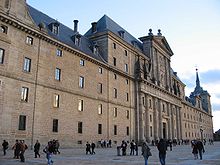
Back العصر الذهبي الإسباني Arabic عصر اسبانيا الدهبى ARZ Sieglu d'Oru AST Залаты век Іспаніі Byelorussian Испански златен век Bulgarian Kantved Aour Spagn Breton Segle d'or espanyol Catalan Siglo de Oro Czech Den spanske guldalder Danish Siglo de Oro German
This article includes a list of general references, but it lacks sufficient corresponding inline citations. (August 2023) |


The Spanish Golden Age (Spanish: Siglo de Oro Spanish pronunciation: [ˈsiɣlo ðe ˈoɾo], "Golden Century") (1492 - 1700)[1] was a period that coincided with the political rise of the Spanish Empire under the Catholic Monarchs of Spain and the Spanish Habsburgs. This era saw a flourishing of literature and the arts in Spain. The most significant patron of Spanish art and culture during this time was King Philip II (1556–1598). However, the period is more broadly associated with the reigns of Isabella I, Ferdinand II, Charles V, Philip II, Philip III, and Philip IV, when Spain was at the peak of its power and influence in Europe and the world.
During this period, Philip II's royal palace, El Escorial, attracted some of Europe's greatest architects and painters, including El Greco. These artists introduced foreign styles to Spanish art, contributing to the development of a uniquely Spanish style of painting.
The start of the Golden Age can be placed in 1492, with the end of the Reconquista, the voyages of Christopher Columbus to the New World, the expulsion of Jews from Spain, and the publication of Antonio de Nebrija's Grammar of the Castilian Language. Amongst scholars of the period, it's generally accepted that it came to an end around the time of the Treaty of the Pyrenees (1659),[2] that concluded the Franco-Spanish War of 1635 to 1659. Others, however, [who?] extend the Golden Age up to 1681 with the death of Pedro Calderón de la Barca, the last great writer of the age. Generally, it is divided into a Plateresque/Renaissance period and the early part of the Spanish Baroque period.
The Spanish Golden Age spans the work of Miguel de Cervantes, the author of Don Quixote de la Mancha; and of Lope de Vega, Spain's most prolific playwright, who wrote around 1,000 plays during his lifetime, of which over 400 survive to the present day. Lope de Vega, Luis de Gongora, and other poets attended the famous Medrano Academy (also known as the Poetic Academy in Madrid) established by Sebastián Francisco de Medrano in 1616.[3][4]
Diego Velázquez, regarded as one of the most influential painters of European history and a greatly respected artist in his own time, was patronized by King Philip IV and his chief minister, the Count-Duke of Olivares.
What is widely acknowledged as some of Spain's greatest music was written during this period. Composers such as Tomás Luis de Victoria, Cristóbal de Morales, Francisco Guerrero, Luis de Milán and Alonso Lobo helped to shape Renaissance music and the styles of counterpoint and polychoral music. Their influence lasted long into the Baroque period, resulting in a revolution of music.

- ^ "The Golden Age of Spain".
- ^ "Golden Age in Spain". www.donquijote.org. Retrieved 6 July 2024.
- ^ Campana, Patrizia, «Hacia una edición anotada de La Filomena de Lope de Vega: Epístola a Don Juan de Arguijo», en Edición y anotación de textos. Actas del Primer Congreso de Jóvenes Filólogos, A Coruña, Universidade da Coruña, 1998, Page 139
- ^ Cañas Murillo, Jesús, «Court and literary academies in the Spain of Philip IV », Yearbook of Philological Studies , 35, 2012, Page 15